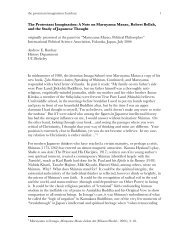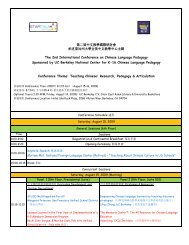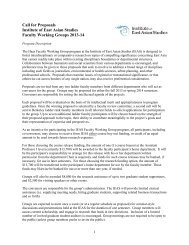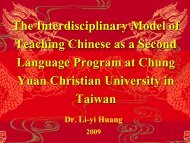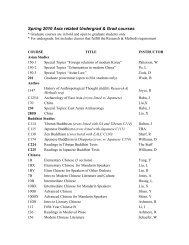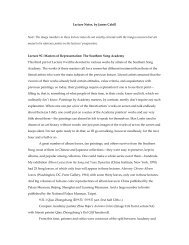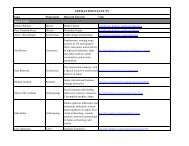Third Edition Spring 2013 - Institute of East Asian Studies, UC ...
Third Edition Spring 2013 - Institute of East Asian Studies, UC ...
Third Edition Spring 2013 - Institute of East Asian Studies, UC ...
You also want an ePaper? Increase the reach of your titles
YUMPU automatically turns print PDFs into web optimized ePapers that Google loves.
these Kautilyan guidelines would, in theory, benefit corporationsinstitutionally deficient in ethical behavior. The fourth component<strong>of</strong> Kumar and Rao’s framework for value-based management is theaccomplishment <strong>of</strong> organizational purpose. This component <strong>of</strong> theframework builds <strong>of</strong>f <strong>of</strong> the previous three components becausean organization can easily achieve its goals if it has a well-definedorganizational philosophy, a capable leader who exists primarilyfor the accomplishment <strong>of</strong> organizations goals, and an organizationalenvironment that promotes ethical behavior. The final componentKumar and Rao discuss in their framework on Kautilyanvalue-based management is feedback on performance. Because thecentral tenet <strong>of</strong> both value-based management and the Arthashastra’sdefinition <strong>of</strong> the ideal king is that a leader and organization existprimarily for the benefit <strong>of</strong> stakeholders, getting feedback fromthese stakeholders is essential. Kumar and Rao claim that “throughsuch feedback, the leader is supposed to sustain various activitiesand thus fulfill the organizational philosophy.” 23 The concept <strong>of</strong>feedback from stakeholders not only completes the Kautilyan totalframework for value-based management, but synthesizes theother components and applies them directly to the main principle<strong>of</strong> value-based management. Kumar and Rao have shown that theArthashastra’s strategies do indeed have practical applications, soKautilya’s ideas remain as relevant to the modern corporate worldas they were to the world <strong>of</strong> ancient Indian kingdoms.The Arthashastra’s contemporary relevance does not, however,lie solely in its potential for application to the world <strong>of</strong> themodern corporation. The treatise is also important for its similaritiesto the classical economics school <strong>of</strong> thought developed in theeighteenth and nineteenth centuries primarily by European economistsAdam Smith, John Stuart Mill, David Hume, Thomas Malthus,David Ricardo, and Jean-Baptiste Say. Although Kautilya hadno influence on these economists because his work was lost duringthe 18th and 19th centuries, his work is significant in what CharlesWaldauer, William J. Zahka, and Surendra Pal call a “neglectedprecursor to classical economics.” 24 Kautilya’s text was centuries23 Ibid., 42124 Charles Waldauer, William Zahka, and Surendra Pal, “Kautilya’s Arthashastra:A Neglected Precursor to Classical Economics,” Indian Economic Review, 31, no. 1ahead <strong>of</strong> Western economics and anticipated many <strong>of</strong> the ideas <strong>of</strong>the great European classical economists. As Waldauer, Zahka, andPal point out, the three principal economic ideas contained in theArthashastra are (1) the value <strong>of</strong> international trade and recognizingthat imports are just as important—if not more important—than exports, (2) a fair and efficient tax system that supplies thestates with income, but does not stifle economic growth, and (3) a“just” wage system rewarding workers for the economic value theycreate, while paying them based on the amount <strong>of</strong> time put in andthe skills necessary for their work. 25 All three <strong>of</strong> these ideas arenot only central to Kautilya’s Arthashastra, but to the classical economicsschool <strong>of</strong> thought developed over two thousand years afterKautilya’s death. The Arthashastra was clearly ahead <strong>of</strong> its time,and anticipated the ideas that Smith, Hume, Ricardo, Mill and othersdeveloped independently <strong>of</strong> Kautilya. If Kautilya’s work had notbeen lost, it may have had a huge influence on classical economics.One can only speculate that trade theory, principles <strong>of</strong> taxation,and the labor theory <strong>of</strong> value associated with classical economicthought might have evolved much earlier (perhaps in thefourteenth or fifteenth century) if Kautilya’s views had been knownto scholars such as St. Thomas Aquinas in the late middle ages orearly Mercantilists in the Renaissance. 26Unfortunately, Kautilya’s work remained lost for a great period<strong>of</strong> time, so the Arthashastra was never able to realize its possiblecontribution to world economic thought. However, India stillfinds great pride in the fact that it “beat” the West to many <strong>of</strong> thepolitical and economic concepts laid out in Kautilya’s text.Because his political and economic ideas were well ahead<strong>of</strong> his Western counterparts like Niccolò Machiavelli and AdamSmith, Kautilya earned a special place among Indian nationalistsduring the Indian independence movement <strong>of</strong> the first half <strong>of</strong> the20th century. The timely discovery <strong>of</strong> the Arthashastra by Sanskritscholar-librarian R. Shamasastry in 1904 allowed Kautilya’s text toattain prominence in the independence movement. Various viewsdeveloped regarding the salience <strong>of</strong> Kautilya for India’s indepen-(1996), 101.25 Ibid., 10226 Ibid., 10763 Ramanathan Veerappan Kautilya’s Arthashastra 64




